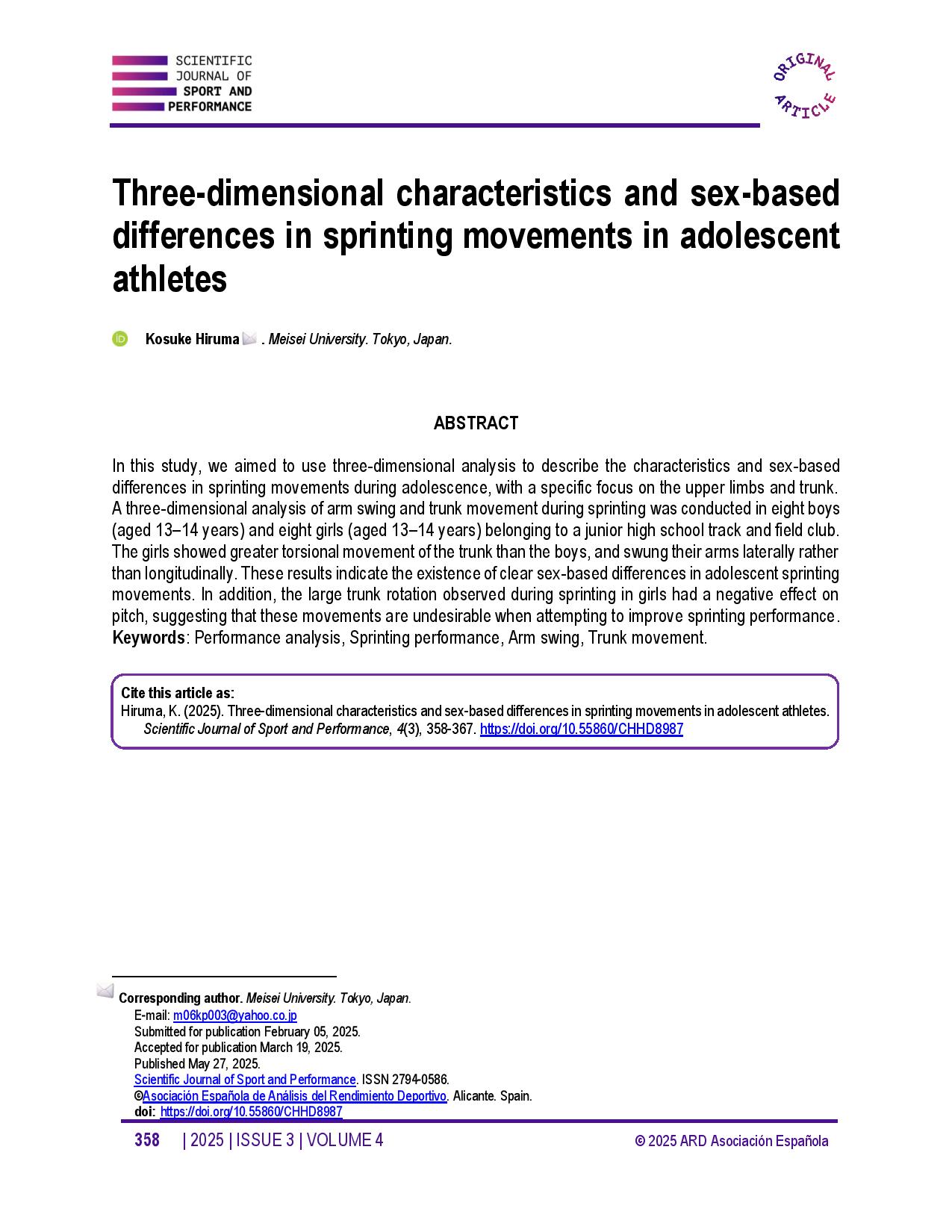Three-dimensional characteristics and sex-based differences in sprinting movements in adolescent athletes
Main Article Content
Abstract
In this study, we aimed to use three-dimensional analysis to describe the characteristics and sex-based differences in sprinting movements during adolescence, with a specific focus on the upper limbs and trunk. A three-dimensional analysis of arm swing and trunk movement during sprinting was conducted in eight boys (aged 13–14 years) and eight girls (aged 13–14 years) belonging to a junior high school track and field club. The girls showed greater torsional movement of the trunk than the boys, and swung their arms laterally rather than longitudinally. These results indicate the existence of clear sex-based differences in adolescent sprinting movements. In addition, the large trunk rotation observed during sprinting in girls had a negative effect on pitch, suggesting that these movements are undesirable when attempting to improve sprinting performance
Article Details

This work is licensed under a Creative Commons Attribution-NonCommercial-ShareAlike 4.0 International License.
References
Abdel-Azis Y. I. and Karara H. M. (1971) Direct linear transformation from computer coordinates into object space coordinates in close-range photogrammetry. Proceedings ASP UI Symposium on Close-range Photogrammetry, American Society of Photogrammetry: Falls Church, pp. 1-19.
Arellano, C.J., & Kram, R. (2011) The effects of step width and arm swing on energetic cost and lateral balance during running. Journal of Biomechanics, 44, 1291-1295. https://doi.org/10.1016/j.jbiomech.2011.01.002 DOI: https://doi.org/10.1016/j.jbiomech.2011.01.002
Bruening, D.A., Baird, A.R., Weaver, K. J., & Rasmussen, A.T. (2020) Whole body kinematic sex differences persist across non-dimensional gait speeds. PLoS ONE, 15, e0237449. https://doi.org/10.1371/journal.pone.0237449 DOI: https://doi.org/10.1371/journal.pone.0237449
Endo,T., Miyashita, K., and Ogata, M.(2007) Kinetics factors of the lower limb joints decelerating running velocity in the last phase of 100 m race. Japan J. Phys. Educ. Hlth. Sport Sci., 53, 477-490. https://doi.org/10.5432/jjpehss.a5302_477 DOI: https://doi.org/10.5432/jjpehss.a5302_477
Hiruma, K., & Kariyama, Y. (2019) A cross-sectional study of the arm swing direction during sprint-running. Japan. Journal of Physical Education, Health Sport Sciences, 64, 719-726. https://doi.org/10.5432/jjpehss.19005 DOI: https://doi.org/10.5432/jjpehss.19005
Hiruma, K. (2022) Characteristics of arm swing movements during sprinting in upper grade elementary school children, focusing on gender and ability differences. Japan Journal of Physical Education, Health Sport Sciences, 67, 79-90. https://doi.org/10.5432/jjpehss.21058 DOI: https://doi.org/10.5432/jjpehss.21058
Ito, A., Ichikawa, H., Saito, M., Sagawa, K., Ito, M., & Kobayashi, K. (1998) Relationship between sprint running movement and velocity at full speed phase during a 100 m race. Japan Journal of Physical Education, Health Sport Sciences, 43, 260-273. https://doi.org/10.5432/jjpehss.KJ00003392100 DOI: https://doi.org/10.5432/jjpehss.KJ00003392100
Kamada, H. (2023) Hamstring strain in track and field athletes. Journal of Joint Surgery, 42 (3), 254-262.
Katoh, K., Kawamoto, K., Sekioka, Y. (1985) A longitudinal study of the development of running ability in junior high school students. Journal of health, physical education and recreation, 35 (11), 858-862.
Katoh, K., Miyamaru, M. (2006) Characteristics of Sprint Motions in High School Students. Japan Journal of Physical Education, Health Sport Sciences, 51, 165-175. https://doi.org/10.5432/jjpehss.51.165 DOI: https://doi.org/10.5432/jjpehss.51.165
Lewis C.L., Laudicina N.M., Khuu A., Loverro K.L. (2017) The human pelvis: Variation in structure and function during gait. The Anatomical Record, 300(4), 633-42. https://doi.org/10.1002/ar.23552 DOI: https://doi.org/10.1002/ar.23552
Malina, R., Bouchard, C., and Bar-or, O. (2004). Growth, Maturation, and Physical Activity. Champaign, IL: Human Kinetics. https://doi.org/10.5040/9781492596837 DOI: https://doi.org/10.5040/9781492596837
Matsuo, S., Fujikawa, H., Matsumoto, A. (2020) Injury rates and patterns in high school track-and-field athletes. Research Quarterly for Athletics, 123, 32-40.
Miyamaru, M. (2001). The Development of Sprint Performance. Tokyo: Kyorinshoin.
Ogiso,K. (2001) Role of the trunk during running exercise. Journal of health, physical education and recreation, 51 (6), 438-443.
Pontzer, H., Holloway, J.H., Raichlen, D.A., Lieberman, D.E. (2009) Control and function of arm swing in human walking and running. The Journal of Experimental Biology, 212, 523-534. https://doi.org/10.1242/jeb.024927 DOI: https://doi.org/10.1242/jeb.024927
Tellez, T., Lewis, C., & Arellano, C.J. (2020) The Science of Speed The Art of the Sprint,; Winning Dimensions Sports: LLC.
Winter, D. A. (2004) Biomechanics and Motor Control of Human Movement (third edition). John Wiley and Sons, pp. 49-50.
Xie P-P, István B and Liang M (2022) Sex-specific differences in biomechanics among runners: A systematic review with meta-analysis. Front Physiol, 13, 994076. https://doi.org/10.3389/fphys.2022.994076 DOI: https://doi.org/10.3389/fphys.2022.994076




